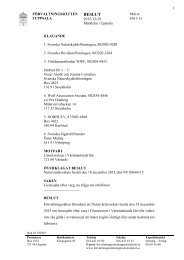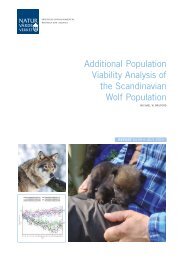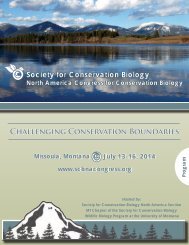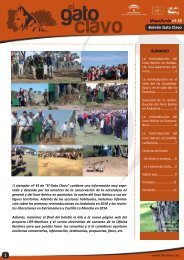1oC3Dbk
1oC3Dbk
1oC3Dbk
Create successful ePaper yourself
Turn your PDF publications into a flip-book with our unique Google optimized e-Paper software.
An invasive seagrass, Halophila stipulacea, was first<br />
discovered in the Caribbean in 2005, arriving from either the<br />
Mediterranean or the Indian Ocean. Since 2005, it has spread<br />
to 15 islands extending across the Caribbean from Aruba to St<br />
John. Although seagrasses are not generally considered to be<br />
invasive, there is evidence that Halophila stipulacea is<br />
displacing one of the native Caribbean species, Syringodium<br />
filiforme; and there is concern for its potential impact on two<br />
other threatened species, Halophila baillonii (Vulnerable) and<br />
Halophila engelmanni (Near Threatened).<br />
Frederick T. Short<br />
Chair, Seagrass Specialist Group<br />
Seahorse, Pipefish and Stickleback<br />
Specialist Group<br />
Project Seahorse, acting as the IUCN SSC Seahorse, Pipefish<br />
and Stickleback Specialist Group, continued to make<br />
measurable strides toward an improved conservation status<br />
for seahorses, in particular. We held a consultative discussion<br />
meeting on the formation of the Specialist Group at the<br />
Syngnathid Biology International Symposium in Faro, Portugal<br />
in March 2013, with about 30 experts on syngnathid biology<br />
attending.<br />
We carried out a rapid assessment of seahorses in<br />
Thailand, as well as studies of seahorse fisheries and research<br />
on seahorse life history in Malaysia. We provided expertise in a<br />
shoreline development project in Hong Kong, and developed<br />
regional identification guides for seahorses in trade for<br />
Southeast Asia which were translated into Thai and Vietnamese.<br />
We collated and synthesized all known material on seahorse<br />
biology, life history, habitats, fisheries, trade, management, and<br />
conservation action for Hippocampus kelloggi, H. kuda, and<br />
H. spinosissimus in Thailand and Vietnam. Technical advice was<br />
provided to scientists, resource managers, aquarium<br />
professionals, aquaculture technicians, and school children.<br />
IUCN Red List assessments have been completed for<br />
eight sticklebacks (Gasterosteidae – only one of which had<br />
previously been assessed). Both pegasids (Pegasidae, sea<br />
moths) were re-assessed and are now awaiting submission,<br />
while assessments for two seahorse species are currently<br />
H. Histrix – Indonesia. © Rudi Rombouts-GuyLian SOTW<br />
under review. We also contributed to the European Red<br />
Listing effort, which includes two sticklebacks<br />
(Gasterosteidae) and 19 Syngnathiformes. We conducted Red<br />
List training for 20 participants at the SyngBio Symposium in<br />
Portugal.<br />
We formally collaborated with CITES Authorities in Thailand<br />
and Vietnam, as they work to implement CITES<br />
recommendations issued under the first Review of Significant<br />
Trade (RST) for any fully marine fish (in this case, for the three<br />
seahorse species mentioned above). This became particularly<br />
important as the Standing Committee banned Vietnam in<br />
March from exporting H. kuda – the first export ban under<br />
CITES for any fully marine fish. We have developed a<br />
framework for making Non-Detriment Findings for Seahorses,<br />
which was reviewed and improved by colleagues in Thailand,<br />
Vietnam and internationally. We also provided information to<br />
UNEP-WCMC during its review of four seahorse species<br />
recently brought under the RST: Hippocampus algiricus,<br />
H. barbouri, H. histrix, and H. trimaculatus. We co-authored<br />
(along with the Chair of the Grouper and Wrasse SG, ex-co-<br />
Chair of the Shark SG and Chair of the SC Policy<br />
Subcommittee) a substantial review paper about CITES and<br />
marine fishes in Fish and Fisheries. Field surveys were<br />
conducted in Senegal to provide trade analysis and biological<br />
data on the heavily exploited species, H. algiricus.<br />
Powered by iNaturalist, we launched iSeahorse, a new<br />
citizen science web-based tool and iPhone app. This venture<br />
allows citizens to upload all seahorse sightings, in a bid to map<br />
distributions and address the Data Deficient status of far too<br />
many seahorse species. We also initiated a national iSeahorse<br />
programme in the Philippines; this will serve as a pilot study for<br />
broader global development. We have created a trends toolkit<br />
for iSeahorse, which will allow users to engage in repeat<br />
monitoring of the same seahorse populations, and therefore<br />
contribute longitudinal data of direct conservation utility. There<br />
were training workshops for potential monitoring teams on the<br />
upcoming trends elements of iSeahorse in Singapore and at<br />
the John G. Shedd Aquarium in Chicago. We frequently share<br />
seahorse information and images via Facebook (3,600 users)<br />
and Twitter (1,600 followers) and we produced 37 blogs;<br />
including stories in National Geographic Newswatch and<br />
Huffington Post.<br />
We gratefully thank a wonderful set of generous and hugely<br />
valued donors and partners for supporting Project Seahorse<br />
and, through us, our SSC work.<br />
Amanda Vincent<br />
Chair, Seahorse, Pipefish and Stickleback Specialist Group<br />
Shark Specialist Group (SSG)<br />
Our vision is for a world where sharks, rays, skates, and<br />
chimaeras are valued and managed for sustainability. Our<br />
mission is to secure the conservation, management and where<br />
necessary, the recovery of the world’s sharks, rays and<br />
chimaeras by mobilizing global technical and scientific expertise<br />
to provide the knowledge that enables action.<br />
In 2013, the SSG completed a strategic planning<br />
exercise and now has a refreshed vision, mission, guiding<br />
principles and core activities. Co-chairs, Nick Dulvy and Colin<br />
Simpfendorfer, and Program Officer Lucy Harrison attended<br />
CITES as part of the IUCN delegation. Lucy Harrison worked<br />
on the IUCN/TRAFFIC review of the proposals, soliciting SSG<br />
80 IUCN species Annual Report 2013






